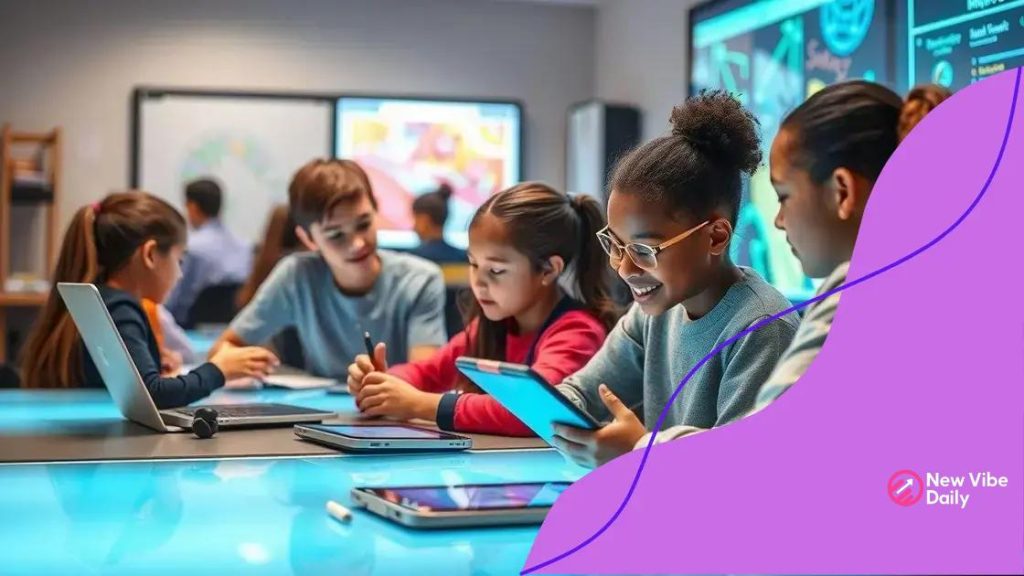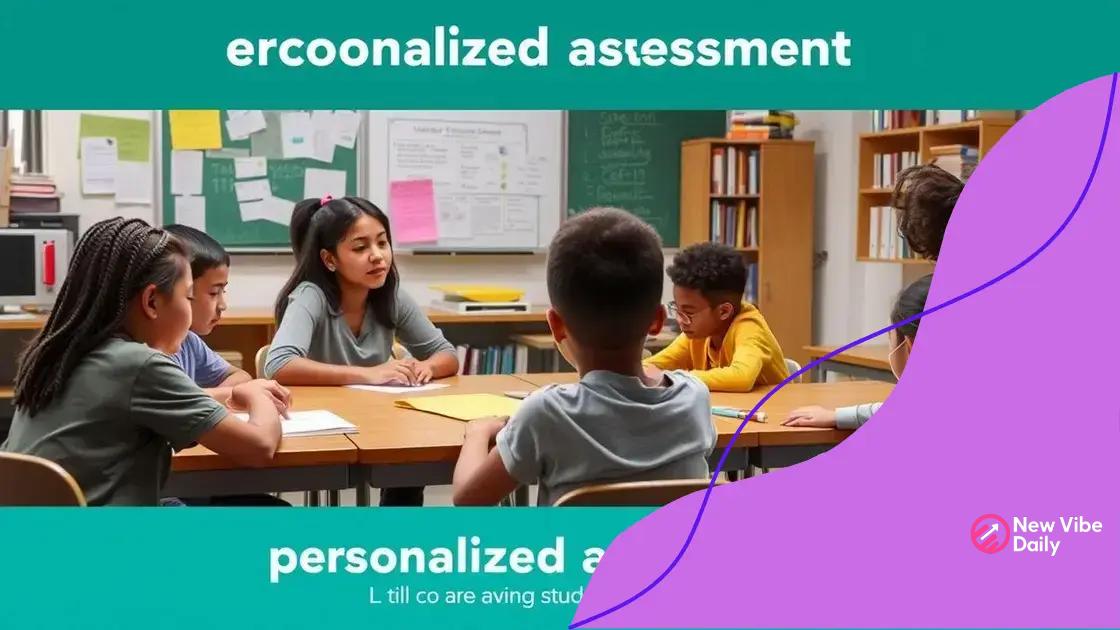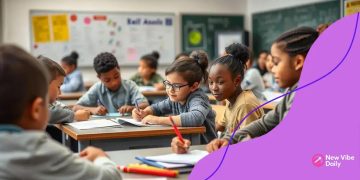Future of educational assessments: What lies ahead?

The role of feedback in learning is crucial as it helps students identify their strengths and weaknesses, promotes a growth mindset, and empowers them to take ownership of their educational progress.
Future of educational assessments is a topic that many educators are curious about. With rapid changes in technology and teaching methods, how will assessments adapt to meet new learning needs? Let’s explore this evolving landscape.
The evolution of educational assessments
The evolution of educational assessments has significantly transformed over the years, adapting to the changing needs of learners and educators. From traditional exams to innovative formats, assessments now reflect a broader range of student capabilities.
Historical Background
In the past, assessments were primarily focused on rote memorization and standardized tests. While these methods had their merits, they often failed to capture a student’s true understanding and skills. Today, we understand that assessments should measure critical thinking and problem-solving abilities.
Modern Approaches
Current trends in educational assessments include:
- Formative assessments: Ongoing evaluations help guide learning and provide immediate feedback.
- Performance-based assessments: These require students to demonstrate their knowledge through projects or presentations.
- Adaptive assessments: Technology tailors the difficulty level to each student’s abilities, making the process more personalized.
As technology advances, so does the variety of assessment tools available. Digital platforms enhance the assessment experience, allowing for interactive and engaging evaluations. Furthermore, educators are increasingly focusing on aligning assessments with real-world tasks to better prepare students.
The integration of data analytics into assessments also plays a crucial role. Educators can analyze performance data to identify trends, strengths, and areas needing improvement. This data-driven approach ensures that assessments are not just a measure of knowledge but also a tool for growth.
Future Directions
Looking ahead, we can expect to see even more significant changes. Innovations in artificial intelligence and machine learning will likely impact how we assess students. With these technologies, assessments will be more individualized and insightful.
Overall, the evolution of educational assessments reflects a more comprehensive understanding of teaching and learning. By embracing diverse assessment methods, educators can support the diverse needs of their students and foster deeper learning.
Technologies impacting assessments
The technologies impacting assessments are reshaping education, making evaluations more effective and engaging. As digital tools become commonplace, they change how teachers and students approach assessments.
Emerging Technologies
One primary factor is the rise of online assessment platforms. These platforms enable teachers to create, administer, and grade tests more efficiently. Students enjoy greater flexibility, allowing them to take assessments from anywhere.
- Artificial Intelligence: AI helps in personalized assessments, adjusting questions based on student performance.
- Learning Analytics: Tools analyze student data to pinpoint strengths and weaknesses, informing instructional adjustments.
- Gamification: Incorporating game elements into assessments makes learning fun and interactive, increasing student engagement.
Moreover, the use of mobile devices enhances access to assessments. Students can complete evaluations on tablets or smartphones, which accommodates various learning environments. In turn, teachers can gather real-time data to support their educational strategies.
Benefits of Technology
Technology in assessments brings numerous benefits. One significant advantage is the immediate feedback provided to students. This instant feedback helps learners understand their progress and promotes a growth mindset.
Additionally, automated grading systems save teachers time and minimize human error. With technology handling assessments, educators can focus more on teaching and less on administrative tasks. Furthermore, technology facilitates collaborative assessments where students work together, fostering teamwork skills.
As educational technology continues to evolve, it will likely lead to more innovative assessment forms. Emerging technologies promise to keep enhancing the accuracy and relevance of evaluations, ensuring that assessments align with current educational goals.
Benefits of personalized evaluations

The benefits of personalized evaluations are becoming increasingly clear in modern education. These tailored assessments focus on individual student needs, promoting a more effective learning experience.
Enhanced Learning Outcomes
One of the primary advantages of personalized evaluations is that they lead to enhanced learning outcomes. By catering to the unique strengths and weaknesses of each student, educators can create assessments that are more relevant. This targeted approach allows students to demonstrate their knowledge in ways that work best for them.
- Improved Engagement: Personalized assessments often increase student engagement, as learners feel more connected to the content.
- Targeted Feedback: Students receive specific feedback that helps them grow in areas where they struggle.
- Increased Motivation: When students see progress tailored to their abilities, they become more motivated to learn.
Another benefit is that personalized evaluations can identify learning gaps more effectively. By focusing on individual progress, teachers can pinpoint exactly where students need help. This data-driven approach facilitates timely interventions, ensuring that no student falls behind.
Builds Confidence
Personalized evaluations also help build student confidence. When assessments align closely with learning styles and paces, students are more likely to succeed. This success fosters a positive self-image and encourages a willingness to tackle new challenges.
Additionally, personalized evaluations promote a growth mindset. Students learn that improvement is possible through effort and targeted feedback. As a result, they become more resilient learners who embrace challenges rather than shy away from them.
In conclusion, the benefits of personalized evaluations extend beyond academic performance. They create a supportive learning environment where students feel valued and understood. By focusing on the individual, these evaluations prepare students to thrive in their educational journeys.
Challenges in modern assessment methods
Despite the advancements in educational assessments, there are several challenges in modern assessment methods that educators face today. Adapting to these challenges requires creativity and persistence from teachers and administrators alike.
Equity and Accessibility
One major challenge is ensuring equity and accessibility for all students. Not every student has the same access to technology, which can create disparities in assessment outcomes. This issue is especially relevant in regions with limited resources. Educators must find ways to provide equal opportunities for all students to demonstrate their knowledge.
- Digital Divide: Some students lack reliable internet or devices.
- Learning Differences: Assessments need to cater to diverse learning styles and abilities.
- Accommodations: Providing necessary support to students with disabilities can complicate assessment processes.
Moreover, time constraints present challenges as well. Teachers often feel pressure to cover an extensive curriculum while simultaneously addressing assessment needs. This can result in superficial teaching practices, where depth of understanding is sacrificed for breadth of content coverage.
Reliability and Validity
Another important consideration is the reliability and validity of modern assessments. If an assessment is not reliable, it can yield inconsistent results, making it difficult to measure true student performance. Likewise, if it lacks validity, it may not effectively assess the knowledge or skills it purports to measure.
As a result, educators must critically evaluate assessment methods to ensure they truly reflect student learning. This process often requires ongoing revisions and improvements, which can be time-consuming.
Furthermore, the rapid pace of technological change can create confusion among educators. Keeping up with new tools and techniques for assessment often requires professional development and training, which may not always be available. Simply put, the landscape of assessment is constantly evolving, making it hard for teachers to stay current.
The role of feedback in learning
The role of feedback in learning cannot be overstated. Feedback is essential in guiding students towards improvement and understanding their progress. It acts as a bridge between teaching and learning, helping students recognize their strengths and areas for growth.
Understanding Feedback
Effective feedback provides specific information about what a student did well and what needs improvement. Rather than simply marking answers as correct or incorrect, good feedback challenges students to reflect on their work. This encourages a deeper level of thinking and engagement with the material.
- Immediate Feedback: Offering feedback right after an assessment helps maintain student motivation and signals areas needing attention.
- Constructive Feedback: This type of feedback focuses on how students can improve, making it essential for fostering growth.
- Regular Feedback: Frequent feedback interactions keep students aware of their progress, reinforcing the learning process.
Feedback can take many forms, including verbal comments, written notes, or digital tools like learning management systems. Each type serves the same purpose — to enhance learning.
Building a Growth Mindset
Feedback also plays a critical role in building a growth mindset among students. When students perceive feedback as a tool for improvement rather than as criticism, they are more likely to embrace challenges and persist through difficulties. This mindset change is crucial for long-term success in education and beyond.
Moreover, the dialogue created around feedback allows students to engage in self-assessment. By reflecting on the feedback provided, students learn to identify their learning goals. This skill is invaluable, equipping them to take ownership of their education.
Understanding the role of feedback in learning highlights its importance in creating an environment conducive to growth. With effective feedback strategies, educators can support students in reaching their full potential.
FAQ – Frequently Asked Questions about Feedback in Learning
Why is feedback important in education?
Feedback is crucial as it helps students understand their strengths and areas needing improvement, guiding them towards better learning outcomes.
How does feedback promote a growth mindset?
Effective feedback encourages students to view challenges as opportunities for growth, fostering resilience and a willingness to learn.
What are some examples of effective feedback?
Effective feedback can include specific comments on assignments, timely responses during learning activities, and continuous dialogue about progress.
How can teachers provide feedback that inspires students?
Teachers can provide constructive, clear, and actionable feedback that highlights what students did well and how they can improve, motivating them to take ownership of their learning.






